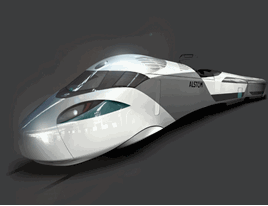High Speed Rail is at the core of Alstom. A pioneer in countries like France, Italy, UK, Spain, South Korea, Finland or Poland, it has the largest fleet of high speed trains in service in the world. More than 1,200 trains with Alstom technology operate daily in 20 countries and across 16 borders. After 34 years of commercial service and over 5.6 billion kilometers, around 3.5bn passengers have travelled in Alstom trains all over the world, including China, Russia and the US.
After building the Eurostar fleet, and building and maintaining the Virgin Pendolino trains, the company is now monitoring developments and engaging with the UK regarding High Speed 2.
Alstom doesn’t just design, build and maintain trains. As well as the vehicles, it can offer a complete railway solution for HS2 including design, procurement, manufacturing, installation, testing and commissioning of the complete railway system consisting of signalling, telecommunications, track, electrification (OLE and power supply), depots and tunnel electromechanical equipment, and the maintenance of the complete system.
Alstom is also one of the world leaders in innovation, and through collaboration with HS2 and partners it is confident it can find a solution to suit the UK’s needs. It can draw on its four decades of global experience and its privileged position in the market to put forward proposals and ideas that could help shape the future of the HS network in Britain.
Alstom HS2 Director Henrik Anderberg believes the company will be able to build on this experience. He tells RAIL: “We are a very British company and we know this market. We understand the UK’s special circumstances and we have the global experience to make it happen through innovation and collaboration with other first class companies.”
While there is clearly a desire to innovate and use new technology, Anderberg believes that existing ideas can also be implemented, building on expertise already in use here in Britain. “We are providing a lot of things with Crossrail - OLE, power supply, track and Electrical and Mechanical (E&M) installations. This project has given us the opportunity to enhance our network of local supplier/ contractors, who can support us with their expertise, which will be needed for HS2.”
But what about the problem of technology moving on while HS2 is being built? Says Anderberg: “It is the same as buying a mobile phone or television - the technology will move on no matter when you buy it.”
Alstom has been working on a new design of slab track to make the system as future-proof as possible. HS2 Ltd’s Technical Director Andrew McNaughton, speaking at the National Rail Conference (NRC) in Leeds on November 5, said that the HS2 track must be able to withstand 60 million tonnes of wear per year. At Alstom, they are up for the challenge. Anderberg says: “We have designed a new slab track called NBT. A lot of work has gone into the theoretical calculations. To test the design we have built 1km of double-track in France, and we also have a test section in Russia.
“Our product would have the 100-year lifespan requested by HS2. Our goal is for a (nearly) zero maintenance, inspection-only slab track system. Inspection is easier and less time-consuming. It means the railway does not need to close at night, allowing, for example, freight trains to run.
“We are now in the process of engaging with different verification bodies in order to be able to have a fully homologated product. Tests are ongoing in Russia, where 200 million tonnes have been done, so far and in two years we should have reached 600 million tonnes.”
This long lifespan concrete slab track system offers high availability and a high construction rate. It has a smaller footprint than ballasted track and is optimised for mixed traffic. The cost of this system versus traditional ballasted track is very favourable when projected over a period of 100 years, thanks to improved operation and lower maintenance costs for the course of its lifespan.
Alstom has developed specialist machinery to install the track. “What differentiates our technology from other slab track solutions is the speed at which the track can be laid. Alstom has developed a specific set of laser-guided machinery capable of simultaneously casting the track slab and inserting the fasteners at speeds of up to 500m a day. The technology is based on the existing and very successful Appitrack machine, used recently in Nottingham for the tramway project.
“With respect to electrification, we have already launched R&D programs that will enable us to homologate our catenary components to the design speeds required by HS2. Our expertise in this area is particularly strong; we have had presence in the very high speed (VHS) electrification of Spain, with more than 550km installed, Korea, with 477km, 200km of VHS in China, more than 700km in Italy on both VHS and HS, not forgetting the 80km performed in the UK as part of HS1.”
Complementing this international experience, Alstom is also working on electrification in the UK, one of several examples being the Edinburgh to Glasgow main line, including OLE and 25kV power supply (traction and feeder systems). This 150km line is under construction and will be in service by the end of 2016. “Knowing the local circumstances and how to electrify in the UK, combined with our extensive knowledge from international projects, will position us well for HS2”, says Anderberg.
Signalling on HS2 will be the new European systems, and this is where Alstom can, again, rely on its vast experience. When it comes to European Railway Traffic Management Systems (ERTMS) across the continent, Alstom’s ERTMS level 2 systems are in operation on more kilometres of track than all other suppliers put together.














Comment as guest
Comments
No comments have been made yet.